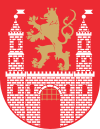Lubsko
| Lubsko | |||
|---|---|---|---|
|
Lubsko castle | |||
| |||
 Lubsko | |||
| Coordinates: 51°47′N 14°58′E / 51.783°N 14.967°E | |||
| Country |
| ||
| Voivodeship | Lubusz | ||
| County | Żary | ||
| Gmina | Lubsko | ||
| Established | before 1258 | ||
| Town rights | 1283 | ||
| Government | |||
| • Mayor | Lech Jan Jurkowski | ||
| Area | |||
| • Total | 12.56 km2 (4.85 sq mi) | ||
| Highest elevation | 122 m (400 ft) | ||
| Lowest elevation | 65 m (213 ft) | ||
| Population (2006) | |||
| • Total | 14,767 | ||
| • Density | 1,200/km2 (3,000/sq mi) | ||
| Time zone | CET (UTC+1) | ||
| • Summer (DST) | CEST (UTC+2) | ||
| Postal code | 68-300 | ||
| Area code(s) | +48 68 | ||
| Car plates | FZA | ||
| Climate | Cfb | ||
| Website | http://www.lubsko.pl | ||
Lubsko [ˈlupskɔ] (German: Sommerfeld, Lower Sorbian: Žemŕ) is a town in Żary County in the Lubusz Voivodeship in western Poland. It is the administrative seat of the Gmina Lubsko and has a population of 15,370 as of February 1, 2005.
History
The town in the historic Lower Lusatia region was first documented in 1258 and received town privileges by the Lusatian margrave Henry III of Wettin in 1283. The name Sommerfeld, German for "summer field", already appeared in an 1106 deed allegedly issued by margrave Henry I of Wettin, who nevertheless had died three years before. The Wettin margraves sold the town to Brandenburg in 1304. Given in pawn several times, Emperor Charles IV of Luxembourg finally granted Lubsko with Lower Lusatia to the Silesian Piast duke Bolko II the Small. After Bolko's death in 1368 it was seized as a reverted fief by the Bohemian Crown.
When the Brandenburg Elector Albert III Achilles of Hohenzollern acquired the nearby Silesian towns of Krossen (Krosno Odrzańskie) and Züllichau (Sulechów) in 1482, the adjacent Lubsko area too came into the possession of Brandenburg and was incorporated into of the Neumark district. From 1816 on the town belonged to the Prussian Province of Brandenburg. In 1846 Sommerfeld received a station on the railway line connecting Berlin with Breslau (Wrocław).
Notable people
- Carl Friedrich Warnstorf (1837–1921), German educator and bryologist
The last German Empress Augusta Viktoria of Schleswig-Holstein was born in Dolzig Palace (Dłużek, part of modern Lubsko) in 1858. The neurologist Alfred Goldscheider was born in Sommerfeld in the same year. Gerhard Domagk attended school in Sommerfeld until he was 14; the scientist would later win the Nobel Prize in Physiology or Medicine in 1939. The actress Joanna Brodzik attended elementary school in Lubsko in the 1980s. Ewelina Flinta the Polish singer was born here.
International relations
Twin towns — Sister cities
Lubsko is twinned with:
 Brody, Poland
Brody, Poland Forst (Lausitz), Germany
Forst (Lausitz), Germany Vlotho, Germany
Vlotho, Germany Helsinge, Denmark
Helsinge, Denmark Pavlohrad, Ukraine
Pavlohrad, Ukraine
External links
| Wikimedia Commons has media related to Lubsko. |
- Municipal website
- Jewish Community in Lubsko on Virtual Shtetl
Coordinates: 51°48′N 14°58′E / 51.800°N 14.967°E


